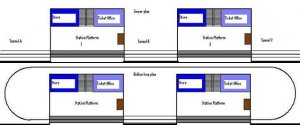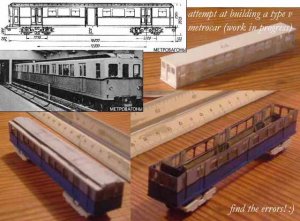Allright - I decided to start building a little layout. One which will fit onto a bookshelf, as I haven't got too much space, but I have some spare bookshelves, and it would be a shame to waste that space.
As a theme for the layout I decided to build a subway, the Moscow metro to be precise, mainly as an excuse to model some of the magnificent architecture of the stations there.
After searching the web for whether something like that had already been done there were very few results. There apparently is some NYC subway rolling stock available, but that's H0 scale, and given the space limitations, N seems to be the only option here. In a fit of insanity I then decided to scratchbuild the cars myself, and while doing that, decided to model in 1:169 given the large gauge used in Russia to be able to use N scale track and wheels.
At the moment my greatest obstacle is designing a nice layout. Given the underground nature, there's plenty of room for unsightly fiddle yards, but getting even station or two (or a two-level station. The platform length needs to be about eleven inches to fit two cars) to fit seems to be a challenge (the space available is a mere 72x15 inch, pretty much in the micro region).
So has anyone done something like this before and do you have ideas on how to tackle the problem of fitting an interesting layout in this space?
Thanks
As a theme for the layout I decided to build a subway, the Moscow metro to be precise, mainly as an excuse to model some of the magnificent architecture of the stations there.
After searching the web for whether something like that had already been done there were very few results. There apparently is some NYC subway rolling stock available, but that's H0 scale, and given the space limitations, N seems to be the only option here. In a fit of insanity I then decided to scratchbuild the cars myself, and while doing that, decided to model in 1:169 given the large gauge used in Russia to be able to use N scale track and wheels.
At the moment my greatest obstacle is designing a nice layout. Given the underground nature, there's plenty of room for unsightly fiddle yards, but getting even station or two (or a two-level station. The platform length needs to be about eleven inches to fit two cars) to fit seems to be a challenge (the space available is a mere 72x15 inch, pretty much in the micro region).
So has anyone done something like this before and do you have ideas on how to tackle the problem of fitting an interesting layout in this space?
Thanks






